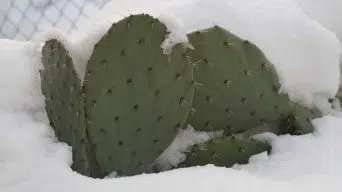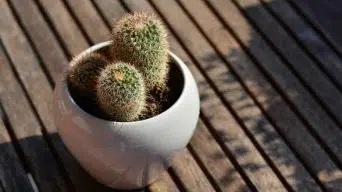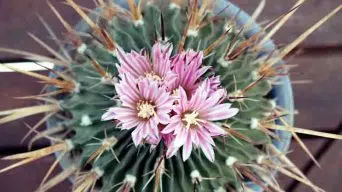To plant a cactus cutting, choose a healthy stem, cut cleanly with sharp scissors, let it dry, and plant about 1/3 of it in well-draining soil. Water sparingly and wait for roots to grow. Place in bright, indirect light and watch your new cactus thrive!
If you’re looking for an easy way to start a garden or add new houseplants to your collection, consider growing a cactus cutting.
Cacti are easy to care for and can be planted in various settings.
Cacti are succulents that come in various shapes and sizes, and they’re perfect for people who don’t have a lot of gardening experience.
This article will provide a step-by-step guide on growing a cactus cutting. So gather your supplies, and let’s get started!
Growing Cactus Cuttings: A Step-by-Step Guide
Cactus plants are easy to grow houseplants and a simple way to create a low-maintenance garden.
If you want to start your cactus collection, the easiest method is often through cuttings.
Cactus propagation is easy and fun and a great way to get free plants!
There are different ways to propagate cactus, but the easiest is by taking cuttings.
This article will show you how to grow cactus cuttings. This easy step-by-step guide makes it simple and easy for anyone to propagate their own cacti.
1. Selecting the Right Cutting
The first step in planting a cactus cutting is to choose the right one.
It’s not always easy to find, but it should be done before starting your project.
Your goal here is to find a healthy, mature piece of cactus that has not flowered recently.
The cutting should also have at least two or three segments, and the end attached to the mother plant should be healthy and free of rot.
2. Taking the Right Cut
The next step to grow cacti, is to take the cutting.
This can be done with any knife or shears and tongs, but it’s best to use sterilized tools to prevent the spread of disease.
You can sterilize your tools by wiping them with rubbing alcohol or holding them over a flame.
Be sure to wear gloves when you’re taking the cutting since cactus spines can be very sharp.
The best time to take cactus cuttings is early in the morning when the plant is still cool and hydrated.
Once you have chosen your cutting, cut it from the mother plant as close to the base as possible.
Try to get at least two or three segments, and ensure the end attached to the mother plant is healthy.
Take the cutting with the tongs and remove any loose spines and dead tissue. Clean the cutting with a damp paper towel or cotton swab to remove any dirt or debris.
3. Allowing Proper Callus Formation
The next step is to callus the cactus pads or cuts.
A cut left exposed to air can lose water and become damaged by pests or disease, so we need to seal the wound with a callusing process.
To callus a cut, place it in a warm and dry area.
A sunny window or grow light will work well. Keep the cutting out of direct sunlight until it has callused over completely.
The callusing process can take up to ten days, depending on how big your cutting is and how hot and dry your environment is.
You know that callusing is complete when the cut has healed and looks dry.
4. Planting Your Cactus Cut
Now that your cutting has been callused, it’s time to plant it.
Choose a pot at least six inches deep with drainage holes in the bottom.
Fill the pot with good-quality potting soil. You can either use a commercial cactus soil mix or make your own by mixing one part potting soil, one part sand and one part perlite.
Place a few rocks in the bottom of the pot to help improve drainage, and then add your cactus mix.
Moisten it slightly by misting it with water, but don’t soak the soil. You can use a spray bottle or just a cup of water to moisten the soil.
Place your cutting on the soil and gently press it down into the potting mix.
To secure the cutting, carefully set it inside the pot to stand upright.
Cover the bottom 1/3 of the plant with the potting mix to prevent the cactus from falling over.
Place it in a warm, dry place where it will receive indirect sunlight and partial shade.
Ensure the area has good air circulation and avoid direct sunlight until your plant root system is established.
5. Proper Watering After Planting
After planting your cactus cutting, you will need to water it regularly.
Watering should be done whenever the soil feels dry to the touch.
You don’t want to soak the soil, but you want to ensure it is always moist.
You can check the moisture level by sticking your finger in the soil.
If the top of the soil is starting to dry out, it’s time to water.
Use fresh water to avoid introducing harmful chemicals or minerals into the soil.
You can either use a spray bottle or pour some water into the pot when watering.
Ensure to water until it starts to come out of the bottom drainage holes, and then let the excess drain away.
Continue watering your cutting until it is well-established and has a good root system.
Then you can reduce the frequency to once a week or even once every other week.
How Long Does It Take Cacti Cuttings to Root?
It can take three to four weeks for a cactus cutting to develop a root system and start producing new growth.
During this time, make sure to keep the soil moist and give your plant plenty of indirect sunlight.
You can know that your cactus starts developing a root system when you see new growth forming.
This will be in the form of small shoots or leaves that are starting to grow from the cut.
Caring for Your Cactus Cutting
Once your cactus has a healthy root system, you can move it to its permanent location and give it more direct sunlight.
However, you will still want to keep it in partial shade until it fully adapts to its new environment.
Depending on how dry the soil is, you can then water your plant once a week or once every two weeks.
If you live in a hot, dry environment, it may need more frequent watering.
You can tell if your plant needs water by checking the soil moisture level.
When the soil’s surface appears dry, it indicates it’s time to provide water to your cactus. It’s important to exercise caution and avoid excessive watering, as this can potentially result in root rot.
Transplanting Your Cactus Plants
Once your cactus grows for three to four months, it will be ready to transplant.
You can either plant it in the ground or repot it into a larger container.
If you repot your cactus, ensure the pot is at least six inches deep and has good drainage.
Use a potting mix specifically made for cacti and succulents, as they need fast-draining soil.
1. Gentle Extraction from the Container
Remove your cactus from the pot by gently squeezing the sides of the container until you can loosen it up.
Then, carefully pull it out and set it on a flat surface. Wear protective gloves when handling cacti, as they have spines that can pierce your skin.
2. Loosening the Soil Around the Roots
Next, you will need to loosen the soil around the roots of your plant so that it doesn’t get too compacted when transplanting.
You can use a small trowel or your fingers to break up the dirt gently. Be careful not to damage any of the roots in this process.
3. Removing Unhealthy Roots
While you have the soil loosened up, take a moment to trim off any dead or dying roots.
These can be identified as dark brown and mushy in texture. Cut them off at the base with sharp garden shears or scissors.
4. Successfully Transplanting Your Succulents
Once the soil is loosened and any dead or dying roots have been trimmed, you can transplant your cacti.
If you are growing your cacti in the ground, make sure to dig a hole that is at least six inches deep.
If you are repotting them into a new container, make sure the pot is at least six inches deep.
Then, place the plant in the hole or container and fill it in with soil, making sure to pack it down gently.
Don’t water your plant for at least a week after transplanting. This will give the roots time to get established in their new environment.
How to Maintain and Care for an Established Cactus Plant
Maintaining and caring for an established cactus plant is essential to ensure its health and longevity. Here are some key steps and tips on how to care for a mature cactus:
- Sunlight: Cacti require plenty of sunlight to thrive. Place your cactus in a location where it receives at least 6-8 hours of direct sunlight each day. South-facing windows are often ideal, but be cautious of scorching in intense midday sun. Outdoor cacti should be positioned in full sun.
- Watering: Cacti are drought-resistant, so it’s crucial not to overwater them. Water sparingly but deeply. Allow the soil to dry out completely between watering, and be sure that your pots has proper drainage. During the growing season (spring and summer), you can water every 2-4 weeks, and reduce watering in the dormant season (fall and winter) to about once a month.
- Soil: Cacti need well-draining soil to prevent root rot. Use a specialized cactus or succulent mix, or amend regular potting soil with perlite or coarse sand to improve drainage.
- Container: If your cactus is in a pot, choose a container with drainage holes to prevent water from pooling at the bottom.
- Temperature: Cacti generally prefer warm temperatures. Keep them away from drafts and extreme cold. Most cacti can tolerate occasional temperature drops but should be protected from frost.
- Fertilizing: Fertilize your cactus during the growing season with a balanced, diluted cactus fertilizer. Follow the manufacturer’s instructions for application, and be cautious not to over-fertilize, as this can harm the plant.
- Pruning: Prune your cactus if it becomes leggy or overgrown. Use clean, sharp scissors or pruning shears to remove unwanted or damaged growth. Allow the cut surfaces to callus over for a few days before replanting or returning it to its container.
- Pests and Diseases: Keep an eye out for signs of pests like scale, mealybugs, or spider mites, and treat them promptly with natural remedies or insecticidal soap. Cacti are generally hardy and resistant to diseases if provided with proper care.
- Repotting: Cacti generally don’t need frequent repotting, as they prefer to be somewhat root-bound. However, if cacti have outgrown their pots or the soil is depleted, consider repotting them into a slightly larger container in the spring. Use fresh soil when repotting.
- Support and Protection: Some larger or top-heavy cacti may need support to prevent them from falling over. You can use stakes or other supportive structures. Additionally, protect your cactus from physical damage, especially if you have children or pets.
Remember that different cactus species may have specific care requirements, so it’s essential to research the particular needs of your cactus variety.
Overall, maintaining an established cactus is relatively low-maintenance, but providing the right conditions is vital for its health and longevity.
Final Thoughts
To grow a cactus from cuttings is a fun and rewarding gardening process that can produce many new plants.
All you need to do is take a cutting, let it dry out for several days, and then plant it in well-draining soil with plenty of indirect sunlight.
Once the plant has rooted and has new growth, you can transplant it into its final location or into a larger container.
Growing and caring for your cactus cut is easy and only requires watering once a week or every two weeks, depending on how dry the soil is.
Make sure to keep it in partial shade until it has fully adapted to its new environment. And be careful not to overwater!
Thank you for reading!







